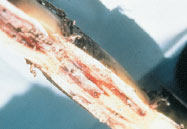Chilo, Sesamia and Scirpophaga spp.

What to look for
Browning of the upper leaves and holes in the stems of sugarcane.
What you can do
- Do not move sugarcane from Papua New Guinea into the Torres Strait Protected Zone to the Torres Strait Permanent Biosecurity Monitoring Zone, or from either zone to mainland Australia without a permit and an inspection by a Department of Agriculture and Water Resources biosecurity officer.
- Report any signs of leaf browning or holes in the stems of sugarcane to the Department of Agriculture and Water Resources by phone on +61 7 4241 7800 or email NAQS.

Profile
The island of New Guinea is the ‘home’ of sugarcane. All commercial sugarcane has been bred from cane originally sourced from New Guinea. These commercial cane plants are very susceptible to damage by pests widely occurring in New Guinea and South East Asia. There are several species of sugarcane stem-borer in New Guinea that cause extensive damage in sugarcane.

Stem-borers feeding in young canes
Identification
Caterpillars feed within the stem of growing canes and may cause enough damage to kill the growing point, resulting in browning of the upper leaves. Other signs are holes in the stem and frass (faecal pellets) caught in the axils of the lower leaves. Some species also feed in the stems of rice, sorghum and corn. Damage to the upper stems of corn plants can result in loss of the male flower, followed by poor pollination of the cobs.
Distribution
These pests are widespread in New Guinea and are found intermittently on the nearby islands of Saibai and Dauan in Torres Strait.
Damage levels as high as 70–80 per cent have been observed in sugarcane in the Western Province of New Guinea.

Caterpillar-infested sugarcane
Threat
Commercial sugarcane species are softer than the wild canes and have higher sugar content. If these pests were to enter our commercial growing areas they would have a severe impact on sugar production and be very difficult to control.
Keep a Top Watch!
If you see sugarcane with holes in the stem report it to your local Department of Agriculture and Water Resources office. There are also state regulations on the movement of sugarcane. Please observe these regulations to help stop the movement of pests and diseases of sugarcane.
Report stem-borer damage on sugarcane.